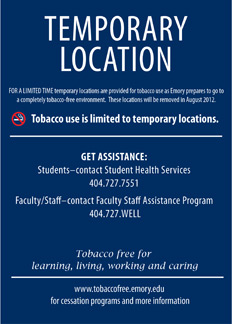Campus News
November 14, 2011
Temporary zones to ease transition to tobacco-free campus

Sample signage indicating a temporary smoking zone.
"As a former smoker for over 20 years, kicking the habit was one of the hardest things I've ever done," admits Steve Thweatt, associate vice president of the Office of Planning, Design and Construction.
And it is the former smoker's perspective that Thweatt brings to the Emory's Tobacco-Free Task Force, as it prepares for the University to become tobacco-free on Jan. 1, 2012.
Thweatt led the Facilities Committee, which met for seven months to map out the popular areas where people currently smoke on campus and to chart efforts for a smooth transition in 2012. They looked at how other institutions like Children's Healthcare of Atlanta and the U.S. Centers for Disease Control and Prevention have fared with similar policies, the impact on adjacent property owners, and consistency with local codes and ordinances.
One of the suggestions from the University community was to have a transitional period during which smokers could use tobacco in specific locations for a limited amount of time as they begin to curtail tobacco use.
As a result, there will be 14 temporary locations on the University and Emory Healthcare campuses on Clifton Road and one on the Briarcliff campus. The temporary zones will take effect Jan. 1 and be phased out next August. See maps of the temporary tobacco zones.
Oxford College will enact the full tobacco ban on Jan. 1 without implementing temporary tobacco zones. Emory University Orthopaedics and Spine Hospital, and Emory Johns Creek Hospital are both currently tobacco-free sites, as is Saint Joseph's Hospital, which is expected to be part of Emory Healthcare soon.
Significant thought was given to where to locate these temporary spots, says Thweatt. The task force evaluated criteria such as: The temporary locations should be isolated enough so that non-smokers are not imposed upon, but not so isolated as to jeopardize personal safety. Most locations are approximately five minutes from work spaces (far enough from entrances, close enough to buildings so that extended smoking breaks are avoided) and avoid areas susceptible to fires. The tobacco zones should accommodate visitors, but not include newly built structures.
As Emory prepares for the implementation of the policy in November and December, expect to see fewer smoking receptacles on campus, and more signage highlighting the change in policy.
"The new signs were designed by our Campus Services graphics group and emphasize that Emory is becoming tobacco-free ‘for learning, living, working and caring.' I think the signage hits exactly the right tone with succinctly positive messaging," says Thweatt.
